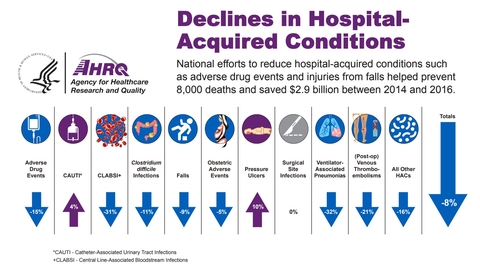Efforts to cut patient safety risks such as adverse drug events or falls saved 8,000 lives and $2.9 billion between 2014 and 2016, according to the Agency for Healthcare Research and Quality's National Scorecard on Hospital-Acquired Conditions released this week.
AHRQ estimates 350,000 hospital-acquired conditions were avoided in that window, reducing the rate of such adverse events by 8%. But while the findings are certainly positive, it doesn't mean providers can rest on their laurels, Rear Adm. Jeff Brady, M.D., director of AHRQ's Center for Quality Improvement and Safety, told FierceHealthcare.
"It's the track we want to be on, but there's still quite a few harms that happen," Brady said. "While we're positive and excited about this, it's not satisfactory to anybody."

The agency found especially significant progress for central line-associated bloodstream infections, which decreased by 31% over those two years. Ventilator-associated pneumonia cases dropped by 32%.
Of the 10 main conditions included in the report, only pressure ulcer and catheter-associated urinary tract infection rates increased between 2014 and 2016.
RELATED: The surprisingly simple way Dignity Health is reducing surgical site infections
The report was released in conjunction with the Centers for Medicare & Medicaid Services, which set a goal of reducing hospital-acquired conditions by 20% between 2014 and 2019. If that goal is met, AHRQ projects that 1.8 million fewer patients will come down with a hospital-acquired infection, saving 53,000 lives and $19.1 billion in hospital costs.
"CMS is committed to moving the healthcare system to one that improves quality and fosters innovation while reducing administrative burden and lowering costs," CMS Administrator Seema Verma said in a statement.
Brady said a crucial element to providers' success so far is taking a more collaborative, wide-ranging view of patient safety. That collaboration includes within a specific hospital, between the hospital and community groups, and teamwork between government agencies at the federal, state and local levels, he said.
"Healthcare is a very complex environment," he said. "Looking at everything in a unique way is not feasible anymore. It's not as much of a project-by-project approach, but more of an across-the-board, coordinated, integrated approach."
RELATED: Leadership rounds could encourage open dialogue on infection control, study finds
A safety-focused culture will also continue to be important, he said.
For its part, AHRQ is consistently working on and evolving how it presents new research and evidence to ensure that it's as useful to providers as possible, Brady said. "We spend a lot of our energy on trying to think about how we can move the evidence into practice," he said.
